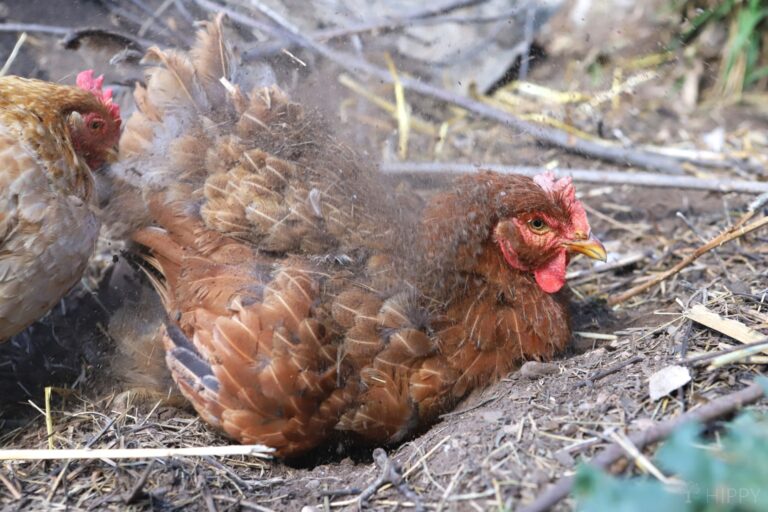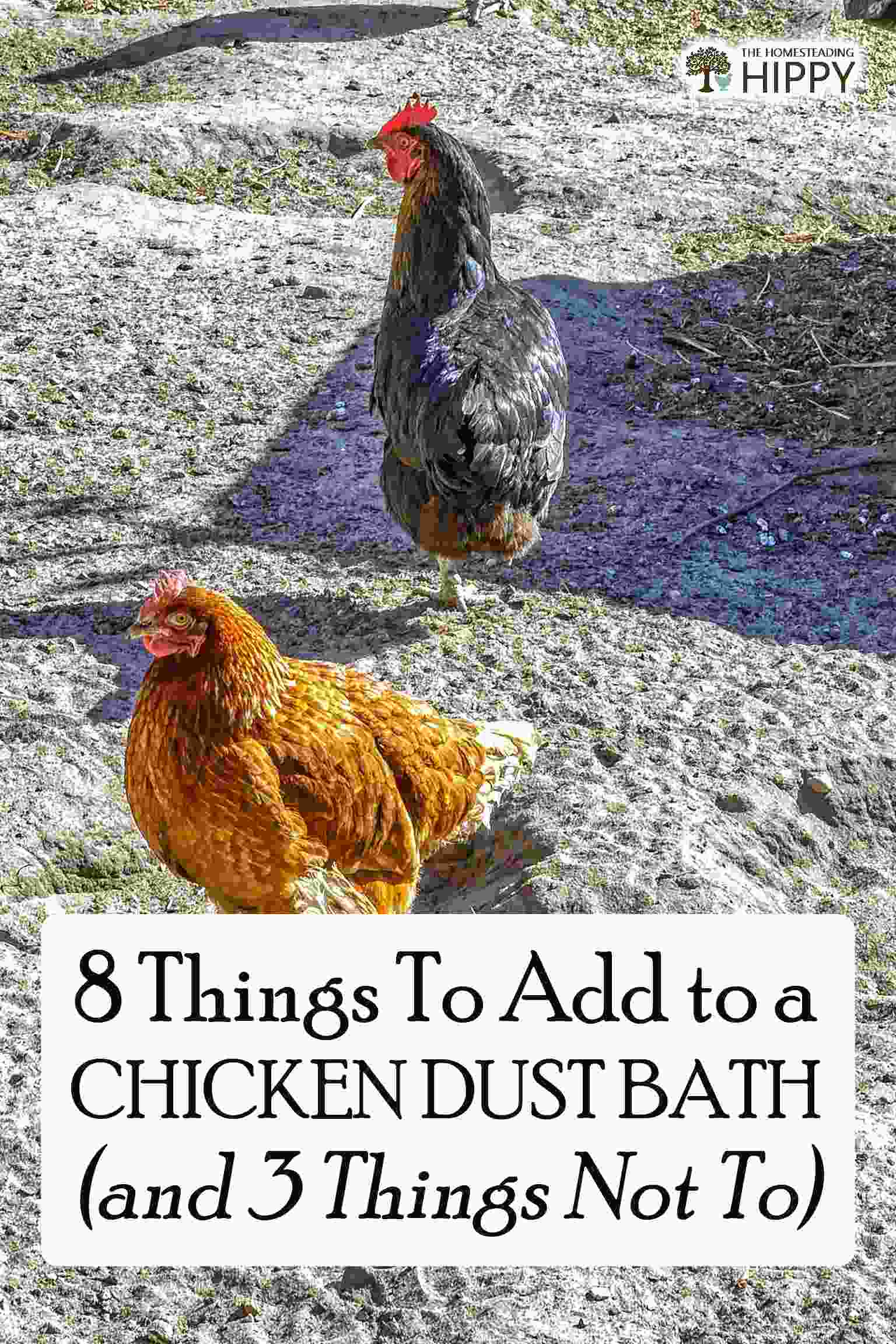When I was a kid, we had a small farm with various animals – including chickens. Now, because I was just a few years old at the time, I only have vague memories of collecting eggs from the chicken coops, walking over dust, and watching as the chickens rolled around in said dust.

Chickens are germophobic, they are very diligent self-groomers and dust bathing allows them to get rid of all the nasty creepy crawly things that can cause health problems for them.
Dust bathing is also good for absorbing excess moisture and oil from a chicken’s body, and is a very social experience. It also loosens old feathers at molting season, allowing the new feathers to come through.
So, why do chickens like them? Well, apart from dealing with parasites; it keeps their feathers clean and healthy and helps them cool down in the summer.
With that said, here are a few ingredients you should add to a chicken dust bath, and a few things you shouldn’t.
Things to Add
- Dirt
- Sand
- Diatomaceous Earth
- Wood Ashes
- Lavender
- Lemon Balm
- Peat Moss
- Sage
- Mint
- Edible Flowers (marigolds, roses, lilacs, apple blossoms, nasturtiums)
- Charcoal
- Rosemary
- Parsley
- Oregano
- Kaolin clay
- First Saturday Lime
- Basil
- Sulfur Dust
Things Not to Add
- Cat Litter
- Coal Ash
- Commercial / Synthetic Fire Log Ash
- Clay
- Sawdust
8 Things You Can Add
✅ 1: Dirt
Dirt is usually a foundational element of any good dust bath. Like I said above, chickens really do get clean by getting dirty! And though your chickens can and will use any loose soil that they can find, you can greatly increase the performance and healthfulness of their dust bath by giving them good dirt to work with.
Dirt that is dry and “clean,” clean meaning sifted for rocks, litter, sticks, and other debris, will always work best.
You might have soil like this on your property that can work if you’re willing to sift it and rake through it to clean it up, or you can cut to the chase and just buy a big bag of potting soil for the purpose.
Dirt is the first and one of the most important components in a good dust bath, but not the only one. Keep reading.
✅ 2: Sand
Sand is another common inclusion in a DIY chicken dust bath, and can be used in equal parts to dirt or included as a smaller amount to improve the cleaning power of the dust bath.
Sand helps the dust bath in several ways. First, it has an abrasive value that helps scrub greasy spots and other contaminants off your chickens’ feathers.
It can also help to dislodge parasites and other pests which can plague your birds. You can use sand in equal parts to the soil above or just add several scoops to the mixture at your preference.
Also, the right kind of sand is important, just like dirt. You want clean, sifted sand ideally, and one where the particles are neither too small nor too large- either means less effectiveness. Play sand or sandbox sand is ideal, readily available, and very cheap.
✅ 3: Diatomaceous Earth
Diatomaceous earth, commonly abbreviated to DE, is an abrasive powder that is made up of the finely ground shells of fossilized diatoms. It has many uses around the home and garden, and one of its best uses is as a component in the dust bath of chickens.
DE is usually mixed in equal parts to dirt, or equal parts to both dirt and sand depending on your objectives.
DE can help feathers stay clean and nice, as well as help loosen up old or failing feathers for an upcoming molt. But its very best use is as a natural, safe insecticide for your chickens.
DE eradicates insects by lacerating their exoskeletons, meaning they will steadily lose moisture, then dry out and die.
Best of all, it won’t hurt your chickens at all and so long as it is dry it is always working, meaning it will help to provide some pest control for the bathing area and the dust bath mix itself.
One more thing, make sure you get food-grade DE for this purpose. Non-food grade DE can potentially irritate the skin of chickens and may cause problems if inhaled since it has a lot of silica in it.
✅ 4: Wood Ashes
Ashes significantly help to improve feather and skin health, and also have antiseptic and insecticidal properties.
Combined with sand and good soil, this can provide a significant improvement in the performance of your dust bath and the health of your chickens. It can also work in tandem with DE above to eliminate serious pest infestations.
✅ 5: Lavender
Lavender is great because, in addition to its pleasant scent, it’s a natural pest repellent. Mosquitos and other types of pests (ants, flies, mites, lice, and ticks) from pestering your birds and causing health problems.
The natural oils present in lavender will help to restore the sheen of your chicken’s plumage and will naturally help them smell great!
Remember that for best results lavender, and other herbs should be dried, not fresh. Freshly picked lavender is probably going to be nibbled at by your birds and won’t work as well.
Consider grinding up the lavender into a fine texture before mixing it in.
✅ 6: Lemon Balm
Lemon balm is not a product, but an herb. Like any other dried herb, it can be added to your dust bath in order to help your chickens heal from minor injuries and stay healthy since it has potent antibacterial qualities.
Plus, it smells really nice, especially in conjunction with other herbs…
Remember to dry it out and grind it up before mixing it in with your dust bath, although if you’re adding it for the fragrance alone you can leave the leaves a little bit larger.
✅ 7: Peat Moss
If you’re living in an area where your soil has a high clay content and you want to keep the dust bath soft and un-clumped, then a bit of peat moss will do the trick. It also keeps your dust bath from becoming a swimming pool, absorbing 20 times its weight in water.
Peat moss might not do a lot for your birds directly compared to some other additives on this list, but it is a great way to help your dust bath stay fresh, dry, and usable.
✅ 8: Sage
Sage has long been used as a staple in the kitchen, and also used in traditional medicine and home remedies throughout the world in various cultures. These same qualities can work for the benefit of your chickens in their dust bath.
Sage can help to soothe hot spots and other kinds of irritation and it also works to ward off parasitic insects, particularly fleas, flies, and other larger pests. You know the drill by now, dry it out, grind it up and mix it in.
✅ 9: Mint
If you want your chickens to smell fresh and clean, you’ll hardly do better than dried mint. Menthol, the compound that gives mint its bracing smell and cool taste, was evolved by the plant as a natural insect repellent and poison.
This means that mint does double duty as a great chicken fragrance and also as a potent insecticide.
In conjunction with sand, wood ashes, and DE mint can help to eradicate any harmful insects and arthropods that happen to be plaguing your flock.
✅ 10: Rosemary
If you haven’t guessed by now, you should know that herbs offer all kinds of benefits to a dust bath, and you would be wise to make them a more regular inclusion.
Rosemary is excellent for its antiseptic qualities, for boosting feather health, and also for its enticing aroma.
✅ 11: Parsley
Adding dried parsley will help your chickens freshen up and avoid illness by forming a natural dirt and germ-repellent layer that will complement the waterproof design of your chicken’s feathers.
✅ 12: Oregano
Oregano is a pungent herb, especially when dried, but one that you should definitely include in your dust bath along with other complimentary herbs. Out of all the herbs on this list, it is oregano that has the most marked antimicrobial and antifungal properties.
It is also a natural insect repellent, at least against certain species like mites and fleas. Same thing applies here: make sure it is thoroughly dried, then break it down and mix it in well
✅ 13: Basil
Basil is a sweet-smelling herb that is useful in all sorts of cuisine, but it also deserves a place in your flock’s dust bath.
Used this way, basil will really just help your birds smell good and stay fresh, but that is reason enough to include it!
✅ 14: Sulfur Dust
Setting up bags of sulfur dust near food dishes so that your birds will rub against them provides an easy and relatively long-lasting method of pest control.
5 Things you Shouldn’t Add
❌ 1. Cat Litter
At first glance, you might think that kitty litter is a good component: It is dusty, smells good fresh out of the bag and it’s supposed to have moisture and germ control properties. However, it will actually end up doing more harm than good.
It is common sense: It seems like common sense, doesn’t it? Cat litter is for cats, not chickens.
You can’t use cat litter in a chicken dust bath! It’s got all kinds of funky additives and fragrances and can cause potential health problems.
❌ 2. Coal Ash
Apart from its awful smell, coal ash contains mercury, sulfur, and heavy metals which will wreak havoc on your birds’ overall health.
This is the very last thing you want to add to any dust bath mixture. The near-term and long-term health risks are just too great. Stick to clean wood ash as described above, and never, ever use coal ash.
❌ 3. Commercial / Synthetic Fire Log Ash
Commercially available, synthetic logs have different types of dyes, resins, glues, and other preservatives/additives which remain present in the ash. This makes the ash unsafe for use as part of a dust bath as the chemicals will cause serious health problems.
If you’re going to use wood ash in your dust bath it had better be from real wood!
❌ 4. Clay
Depending on where you live or where you are sourcing your soil from, you’ll need to be very careful to check for clay content. High clay soils will completely ruin your dust bath mixture.
Clay will hold water and stick to the feathers of your birds, staining and fouling them terribly. It will also bind the smaller particles in your mixture so they can’t do their job, neutralizing the effectiveness of sand and diatomaceous earth.
If you have any doubts about the clay content of your soil and don’t want to mess with testing it, just buy some potting soil or get some clean, sifted, low/no-clay dirt from a landscaping supply company.
❌ 5. Sawdust
Sawdust is another one of those tricky things that at first glance seems like a good inclusion for a dust bath, but it rarely is.
Even using natural sawdust taken from freshly filled trees or logs can be problematic due to the moisture content of the sawdust and the presence of sap, which can start to foul up your dust bath mixture.
You definitely shouldn’t use sawdust from commercial lumber and treated lumber in particular because it will introduce a variety of harmful chemicals that your birds don’t need to be splashing all over themselves.


Greg spent most of his childhood in camping grounds and on hiking trails. While he lives in the suburbs nowadays, Greg was raised on a small farm with chickens. He’s a decent shot with a bow, and a huge knife enthusiast. Find out more about Greg.

How do you recommend adding lemon? Squeeze some lemon juice in? Grind up lemon peels? We grow lemon trees so we have plentiful access to lemons!
It states lemon balm which is different than lemons from your tree.